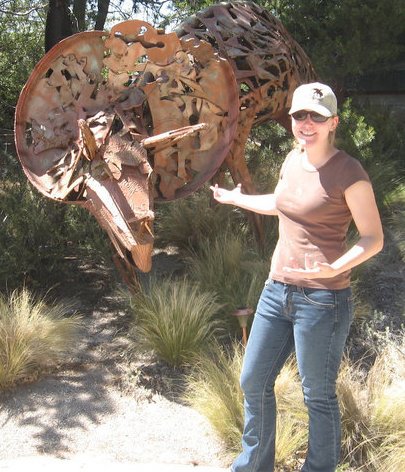This is the second post of my two post entry on my first Thanksgiving in NM.
The day after Thanksgiving Lev, Matt, and I went out and about to burn off some of the extra calories from the previous evening. We went to the west mesa volcanoes, which are part of the Petroglyph National Monument. It was refreshing to see that a lot of other people had the same idea; rather than go shopping like too many people do the day after Thanksgiving, they were outside enjoying the good weather. It was, indeed, a beautiful day, and the scenery was equally lovely.
 |
| Matt, Melissa, and Lev. Two paleontologists and an astrobiologist. In the background, a volcano. |
We hiked around for a good 2 hours. From up on the volcanoes themselves we got a great view of the city of Albuquerque.
 |
| Far background: the Sandias. Foreground: west mesa. Middle and below: Albuquerque, NM | | |
|
The mesa is made of a volcanic rock called basalt. Rifting in the area caused the valley and volcanoes to form. The rift is still somewhat active, so the volcanoes themselves aren't totally dormant. I seriously doubt, however, that they will be doing anything interesting in the near future.
 |
| The tall rectangle that is roughly in the middle of the picture is the Bank of the West building. I live about 2 blocks to the west of that building. In the far background are the Sandia Mountains to the east. |
|
|
|
|
|
It's amazing how pretty the high-desert is, desolation has its beauty.
 |
| One of a number of volcanoes. We wandered around this big one for a while, it was too tall for me to want to climb, as I was running out of water. |
|
|
 |
| Sitting, watching the daylight run out. |
Saturday was an entirely different adventure. For those of you who remember "Contact", the array of what looked like a bunch satellite dishes in the middle of nowhere was filmed for the movie at a real place 44 miles west of Socorro, NM on the Plains of San Augustine. The Very Large Array (that's its real name, also referred to as the VLA) consists of 27 209-ton antennas ("dishes") that can be moved around into different configurations to look at objects in space. This is similar to using a typical telescope, only light waves aren't observed. Objects such as planets, black holes, stars, etc. give off radio waves; these are collected by each "dish" and interpreted by a computer so that scientists can look at the images.
We were at the VLA right before dusk with Dave and Mouse, and I got some rather neat pictures before the sun went down.
 |
| Tracks which are used to move the antennas around. |
 |
| National Radio Astronomy Observatory VLA. |
 |
| Radio telescope sentinels, standing in a row |
 |
| Sunset on the Plains of San Augustine |
 |
| These a really rather large |
 |
Looking up
|













:-D "dishes"!
ReplyDeleteThat last shot is crazy good. And I love the sign for the "Very Large Array." It's probably next to the "Large Array," a few acres away from the "Moderately Sized Array," and on the other side of the field from the "Relatively Small Array." Creative bunch, those scientists... ;)
ReplyDelete